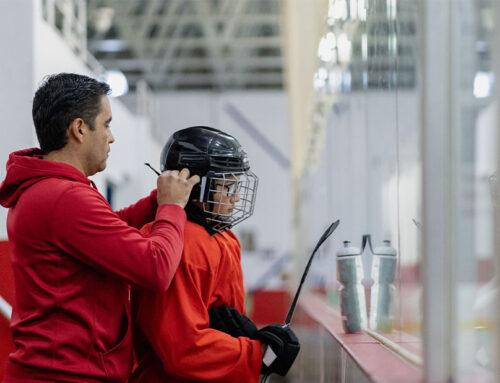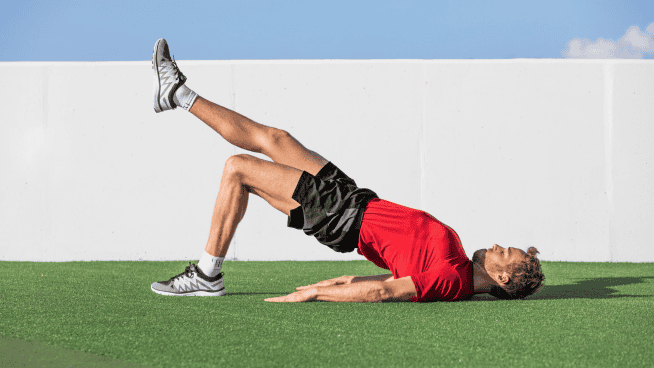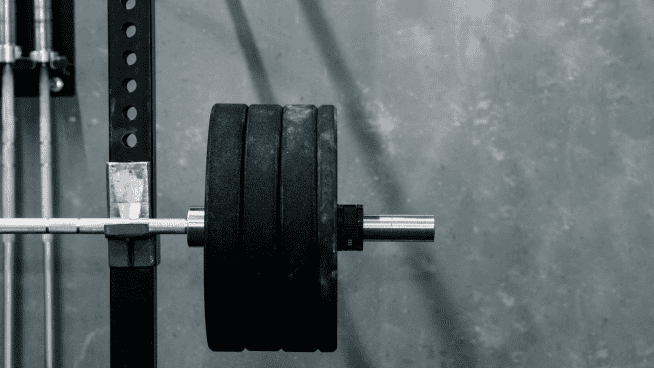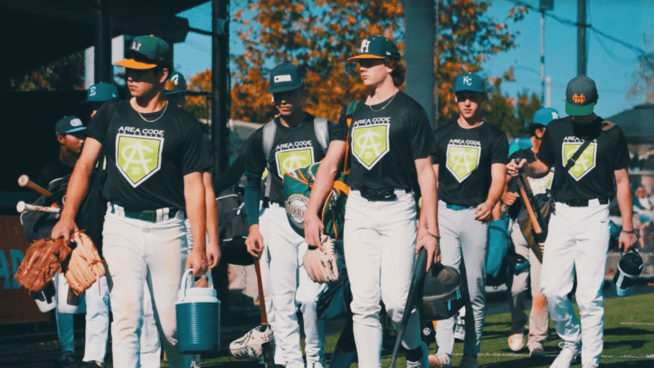Tips For Coaching Flag Football
Rain poured. Ten drenched middle school boys and I slid across the grass with smiles plastered across our faces as we ran routes, threw the football, and made our way up and down the field. I was in my early 40’s at the time and loved every minute of it.
This is one of my favorite memories from my time coaching flag football. We always had fun, I made sure of that, but that practice stands out for some reason. The boys learned about the game. We worked on skills that would translate to tackle football and other sports and learned about being part of a team. Still, that wet scrimmage when we were all enjoying the game reminded me what youth sports are about, having fun.
I coached girl’s basketball, and my husband played football in college, so coaching my son, his friends and other boys from the neighborhood was a great experience. I also learned a few things along the way.
Be Organized and Prepared
Some coaches might think, it’s just recreational flag football, I’ll wing. Well, I would recommend that you come prepared. With my history coaching at a competitive level, I have found that having a practice plan makes all the difference in the world. Of course, you can adjust practice depending on what is happening, how many players show up to practice, how the drills are going, but going in prepared helps you get the most out of your time and helps the athletes learn more.
Get Help Coaching
If possible, find help. Talk to a friend or the parents and see if you can get an extra hand to make practice go more smoothly. This will allow the team to break out into smaller groups during drills. The athletes will get more reps, learn more, have more fun, and so will you.
Keep Talking to a Minimum
Young athletes, even old ones, get bored if you talk, talk, talk. Of course, you need to talk about the schedule and your expectations, relay concepts, share fun antidotes and explain drills, but if you only have an hour or two of practice, make good use of it. Don’t have the athletes standing and listening to a ton. This is where having a practice plan helps keep your schedule going and the talking to a minimum.
Keep Athletes Moving
When scheduling your practice, keep the periods for each drill relatively short. I set 5-10 minutes depending on the drill. The first time you run a drill, you will need a little extra time to explain how to run it and the concepts around it, but once the athletes get the activity down, you can move quickly between drills. It’s a win-win. They learn more and have more fun.
Teach the Fundamentals
I wanted the boys to learn skills that would help them if they went on to play tackle football or simply other sports. I taught them proper alignment and stance, how to carry the ball, throw the ball, catch the ball, snap the ball, handoff/exchange the ball, basic run routes, proper stance, pursuit angles, containment, footwork, back peddling and breaking down, flag pulling and defense.
Drills
Check out these links for drill ideas:
- Flag Football Academy Drills
- NFL Flag Football
- Y-Coaching Drills
- Broncos Flag Football
- Youth Flag Football
10 Best U8 Flag Football Drills
10 Best U6 Flag Football Drills
Keep It Simple
Especially when a team is young, I recommend keeping it simple. Keep the drills simple and keep the plays simple. As the season progresses, read how your players are doing and increase the skill level of drills as needed. The coaches were allowed in the huddle when I coached, so I put together several laminated cards with our basic sets. What I used was similar to what can be found at Flag Football Playbook. Mine were even more simple, but this will get you started.
By the time our team started playing games, all of our players had understood the basics and had learned about all positions. We had five players on the field at a time. With one at center and one at quarterback, we were left with three players for the other positions. We would either put all three on the line for running routes or have two on the line with one back to run (usually a sweep). When we would get in the huddle, I would pull out a card and tell the other three boys their positions. Some coaches set up a color codes system. I would recommend doing what works best for you depending on the level of your players, just build off the basics.
Involve All The Players
Not everyone will always get to play all positions, but it’s recreational football so all players should get time in the game. I talked to the players, saw where they wanted to play, and matched that to where they had more ability. For example, if you have a player who can’t catch the ball well, have them run the ball a little more or use them with shorter pass routes. And they can’t all play quarterback all the time, so you will probably have two or three who play that position more than others. The rest will spend more time at center, wide receiver and running back positions. Work with your athletes so that they learn and are ready to play different positions. Work with them to find success.
Encouragement
Always be positive. This is a learning experience. I had some boys who had never played football before and others who had been throwing a football for a majority of their lives. It’s important to have the teamwork together to encourage one another. It’s amazing how much it helps a young athlete to have their coach, as well as other teammates, encourage them when they are learning.
Make It Fun
Having a practice plan helps make things run more smoothly, which usually means more fun. One thing to remember is to keep your athletes moving; they will have more fun if they are not standing around. Use your athlete’s competitive spirit to get the team’s energy flowing. Set up relays with some of the drills you are working on.
Use your imagination. Break into teams and set up cones depending on what you’ve put together in your practice plan. It could be a simple as having the teams line up the goal line, then when you blow the whistle, the first person in line picks up a football and runs it to the 10 yard line and sets it down. Then they back peddle to a cone on the 20-yard line. Maybe you have them do a pushup or two or three or ten here. Then have them sprint to pick up the ball and pass it to the next player on their team standing in line at the goal line. Use basic skills you’ve been working on to a make a relay.
Coaching young athletes can be challenging, and for those learning a new sport or getting better at one, it is not always easy. But the bottom line is, flag football is a blast, so find ways that both you and your team will leave practices with a smile.
RECOMMENDED FOR YOU
MOST POPULAR
Tips For Coaching Flag Football
Rain poured. Ten drenched middle school boys and I slid across the grass with smiles plastered across our faces as we ran routes, threw the football, and made our way up and down the field. I was in my early 40’s at the time and loved every minute of it.
This is one of my favorite memories from my time coaching flag football. We always had fun, I made sure of that, but that practice stands out for some reason. The boys learned about the game. We worked on skills that would translate to tackle football and other sports and learned about being part of a team. Still, that wet scrimmage when we were all enjoying the game reminded me what youth sports are about, having fun.
I coached girl’s basketball, and my husband played football in college, so coaching my son, his friends and other boys from the neighborhood was a great experience. I also learned a few things along the way.
Be Organized and Prepared
Some coaches might think, it’s just recreational flag football, I’ll wing. Well, I would recommend that you come prepared. With my history coaching at a competitive level, I have found that having a practice plan makes all the difference in the world. Of course, you can adjust practice depending on what is happening, how many players show up to practice, how the drills are going, but going in prepared helps you get the most out of your time and helps the athletes learn more.
Get Help Coaching
If possible, find help. Talk to a friend or the parents and see if you can get an extra hand to make practice go more smoothly. This will allow the team to break out into smaller groups during drills. The athletes will get more reps, learn more, have more fun, and so will you.
Keep Talking to a Minimum
Young athletes, even old ones, get bored if you talk, talk, talk. Of course, you need to talk about the schedule and your expectations, relay concepts, share fun antidotes and explain drills, but if you only have an hour or two of practice, make good use of it. Don’t have the athletes standing and listening to a ton. This is where having a practice plan helps keep your schedule going and the talking to a minimum.
Keep Athletes Moving
When scheduling your practice, keep the periods for each drill relatively short. I set 5-10 minutes depending on the drill. The first time you run a drill, you will need a little extra time to explain how to run it and the concepts around it, but once the athletes get the activity down, you can move quickly between drills. It’s a win-win. They learn more and have more fun.
Teach the Fundamentals
I wanted the boys to learn skills that would help them if they went on to play tackle football or simply other sports. I taught them proper alignment and stance, how to carry the ball, throw the ball, catch the ball, snap the ball, handoff/exchange the ball, basic run routes, proper stance, pursuit angles, containment, footwork, back peddling and breaking down, flag pulling and defense.
Drills
Check out these links for drill ideas:
- Flag Football Academy Drills
- NFL Flag Football
- Y-Coaching Drills
- Broncos Flag Football
- Youth Flag Football
10 Best U8 Flag Football Drills
10 Best U6 Flag Football Drills
Keep It Simple
Especially when a team is young, I recommend keeping it simple. Keep the drills simple and keep the plays simple. As the season progresses, read how your players are doing and increase the skill level of drills as needed. The coaches were allowed in the huddle when I coached, so I put together several laminated cards with our basic sets. What I used was similar to what can be found at Flag Football Playbook. Mine were even more simple, but this will get you started.
By the time our team started playing games, all of our players had understood the basics and had learned about all positions. We had five players on the field at a time. With one at center and one at quarterback, we were left with three players for the other positions. We would either put all three on the line for running routes or have two on the line with one back to run (usually a sweep). When we would get in the huddle, I would pull out a card and tell the other three boys their positions. Some coaches set up a color codes system. I would recommend doing what works best for you depending on the level of your players, just build off the basics.
Involve All The Players
Not everyone will always get to play all positions, but it’s recreational football so all players should get time in the game. I talked to the players, saw where they wanted to play, and matched that to where they had more ability. For example, if you have a player who can’t catch the ball well, have them run the ball a little more or use them with shorter pass routes. And they can’t all play quarterback all the time, so you will probably have two or three who play that position more than others. The rest will spend more time at center, wide receiver and running back positions. Work with your athletes so that they learn and are ready to play different positions. Work with them to find success.
Encouragement
Always be positive. This is a learning experience. I had some boys who had never played football before and others who had been throwing a football for a majority of their lives. It’s important to have the teamwork together to encourage one another. It’s amazing how much it helps a young athlete to have their coach, as well as other teammates, encourage them when they are learning.
Make It Fun
Having a practice plan helps make things run more smoothly, which usually means more fun. One thing to remember is to keep your athletes moving; they will have more fun if they are not standing around. Use your athlete’s competitive spirit to get the team’s energy flowing. Set up relays with some of the drills you are working on.
Use your imagination. Break into teams and set up cones depending on what you’ve put together in your practice plan. It could be a simple as having the teams line up the goal line, then when you blow the whistle, the first person in line picks up a football and runs it to the 10 yard line and sets it down. Then they back peddle to a cone on the 20-yard line. Maybe you have them do a pushup or two or three or ten here. Then have them sprint to pick up the ball and pass it to the next player on their team standing in line at the goal line. Use basic skills you’ve been working on to a make a relay.
Coaching young athletes can be challenging, and for those learning a new sport or getting better at one, it is not always easy. But the bottom line is, flag football is a blast, so find ways that both you and your team will leave practices with a smile.










